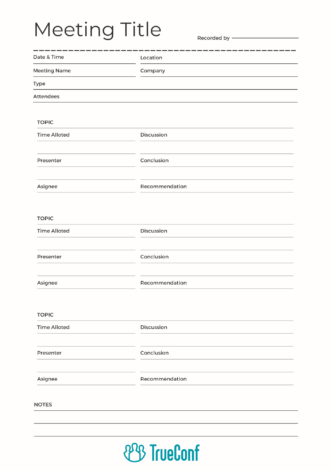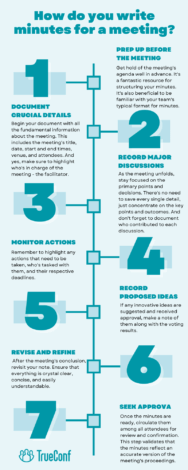How To Write Effective Meeting Minutes
What are Meeting Minutes?
Regardless of your feelings towards them, gatherings are routine elements of your professional life. The only way to evade them is retirement. These gatherings could be as informal as team discussions or as formal as board meetings, but they all require one thing: the documentation of minutes.
The summary of a meeting, or the meeting minutes, serve as an informal journal of the discussion. It includes the major topics of conversation, any innovative suggestions that emerged, and the resulting action points. Typically, a designated team member undertakes the task of documenting these minutes. Their role, if they agree to it, is to create an accurate reflection of the events that occurred during the meeting.
The Value of Recording Meeting Minutes
Meeting minutes are our reliable companions during discussions! They aid us in recording all the substantial elements that arise – the conversation, the reports we pursue, any new thoughts that emerge, and even potential subjects for our upcoming sessions. To further enhance the effectiveness of your meetings, consider exploring our comprehensive guide on business meeting practices.
In a meeting, you can adopt an investigative approach by monitoring how projects are progressing with other teams. You can identify where a little push might be required to ensure things operate smoothly. They also highlight who’s steering different projects and tasks, and how well they’re performing their duties.
Essential Elements for Assembling Meeting Minutes
Let’s dive into your meeting recap! It’s probably going to be customized considering your company’s unique necessities and the manner of meetings you frequently hold. But don’t sweat it, there are some components that generally pop up in most meeting recaps:

- Basic Meeting Information: At the very beginning of your document, remember to type critical details like the meeting’s title, its location, the date, and time. This ensures everything’s well-organized and allows you to identify the meeting specifics instantly.
- Attendee List: Next up, let’s keep tabs on the attendees. Compile a list of everyone present at the meeting. Every time you are writing a meeting invitation email or sending out any communication related to the meeting, ensure you have an up-to-date list of attendees. It’s not just about collecting names – it offers a glimpse into who’s in charge of a specific topic.
- Meeting Goal: Much like every captivating movie has a storyline, every set of meeting minutes requires a goal. Of course, you may delve into numerous topics, but there should be one primary objective on the agenda.
- Discussed Topics: And certainly not least, ensure your meeting minutes encompass a complete record of all the subjects that were debated. Whether you discussed integration issues or explored strategies for enhancing customer engagement, each topic should be thoroughly documented. Collaborate with the person directing the meeting to note these topics prior to the meeting’s start.It’s a good tactic to make your note-taking a bit easier!
Explore the cutting-edge capabilities of TrueConf video collaboration system powered by automatic transcription solutions provided by our technological partners! Capture business-critical decisions made by meeting participants, streamline reporting, and get seamless access to the necessary information in the future.
TrueConf AI Server
A smart algorithm can easily capture the details of any discussion and autogenerate the transcription, considering specialized terminology and punctuation.
How do You Write Minutes for a Meeting?
Creating meeting minutes can be an effortless process with the correct procedures. Here’s a guide for you:
1. Prep Up Before the Meeting
Get hold of the meeting’s agenda well in advance. It’s a fantastic resource for structuring your minutes. It’s also beneficial to be familiar with your team’s typical format for minutes.
2. Document Crucial Details
Begin your document with all the fundamental information about the meeting. This includes the meeting’s title, date, start and end times, venue, and attendees. And yes, make sure to highlight who’s in charge of the meeting – the facilitator.
3. Record Major Discussions
As the meeting unfolds, stay focused on the primary points and decisions. There’s no need to save every single detail, just concentrate on the key points and outcomes. And don’t forget to document who contributed to each discussion.
4. Monitor Actions
Remember to highlight any actions that need to be taken, who’s tasked with them, and their respective deadlines.
5. Record Proposed Ideas
If any innovative ideas are suggested and received approval, make a note of them along with the voting results.
6. Revise and Refine
After the meeting’s conclusion, revisit your note. Ensure that everything is crystal clear, concise, and easily understandable.
7. Seek Approval
Once the minutes are ready, circulate them among all attendees for review and confirmation. This step validates that the minutes reflect an accurate version of the meeting’s proceedings.

Remember, the minutes are there to present the summary of the meeting’s actions and decisions.
Finally, always maintain discretion. Only include sensitive details in the minutes if they’re absolutely indispensable.
About the Author
Nikita Dymenko is a technology writer and business development professional with more than six years of experience in the unified communications industry. Drawing on his background in product management, strategic growth, and business development at TrueConf, Nikita creates insightful articles and reviews about video conferencing platforms, collaboration tools, and enterprise messaging solutions.





Follow us on social networks